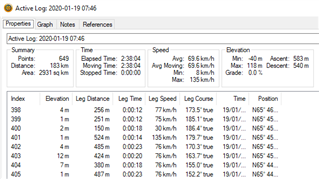I am using Basecamp 4.7.1 on Windows to view a track log recorded on a Drive Smart 61. The log contains 649 points from a 2 hour 38 minutes drive of 183 km. Point 401 gives a speed of 135 KPH which I know is false - it is way too high.
I have no reason to believe my speed at point 401 was any higher than my speed elsewhere. The second highest speed recorded was 83 KPH. How/why does this one value show such a false reading? It is a concern that the data recorded can be so badly wrong; how can I rely on any of the speed data if it can be this far out?
Point 400 shows 30 KPH and point 402 shows 76 KPH. I suspect the 30 KPH at point 400 is also wrong: it is probably too low. If I take the leg distance and leg time for 400 and 401 combined it would give a speed of 76 KPH which looks accurate. So it seems to me as if the device recorded too low a distance for 400 and too high a distance for 401, with the 2 errors totalling to the correct answer but each one individually being wrong.

A bonus question on the same subject: when looking at the track log in Basecamp, how can I select all the points in the lest except point 401?


